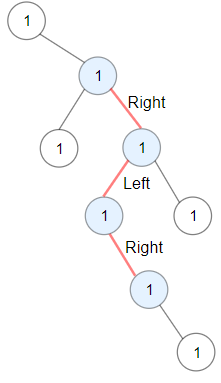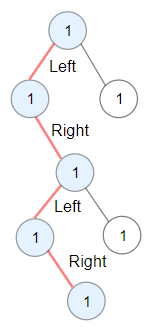You are given the root of a binary tree.
A ZigZag path for a binary tree is defined as follow:
- Choose any node in the binary tree and a direction (right or left).
- If the current direction is right, move to the right child of the current node; otherwise, move to the left child.
- Change the direction from right to left or from left to right.
- Repeat the second and third steps until you can't move in the tree.
Zigzag length is defined as the number of nodes visited - 1. (A single node has a length of 0).
Return the longest ZigZag path contained in that tree.
Example 1:
Input: root = [1,null,1,1,1,null,null,1,1,null,1,null,null,null,1,null,1] Output: 3 Explanation: Longest ZigZag path in blue nodes (right -> left -> right).
Example 2:
Input: root = [1,1,1,null,1,null,null,1,1,null,1] Output: 4 Explanation: Longest ZigZag path in blue nodes (left -> right -> left -> right).
Example 3:
Input: root = [1] Output: 0
Constraints:
- The number of nodes in the tree is in the range
[1, 5 * 104]. 1 <= Node.val <= 100

